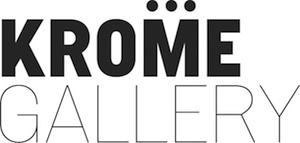•
AMIE SIEGEL
BLACK MOON
05.10. – 13.11.2010
Opening: Saturday, 2 October 2010, 6 – 9 pm
•
click the picture to launch gallery
•
Krome Gallery presents the European premiere of “Black Moon”, the newest multi-part work by American artist Amie Siegel, which recently premiered in the USA in the 2010 Foster Prize Exhibition at the Institute for Contemporary Art, Boston. “Black Moon” consists of three works – a 20-minute film, a series of photographs and a two-channel video installation.
The centerpiece of the exhibition at Krome Gallery is a large-scale projection of the film “Black Moon” (2010) shot in super16mm. Siegel’s latest montage of fictional and non-fiction elements blurs the boundaries of different genres and narrative structures. Set in the real-life post-apocalyptic landscape of foreclosed and abandoned gated communities in Florida and the California, “Black Moon” stages a revolutionary troop of armed women surviving an unspecified war. The houses were never lived in or abandoned by their owners or developers during the last economic crisis. Shot in slowly moving and still sequences, the houses and empty streets become protagonists of a silent narrative, a documen-tary of the recent past. However, these real-estate developments also function as the fictional setting for the female soldiers traversing a surreal suburban topography seemingly absent of other humans. Wandering through abandoned environments, pushed on by gunfire and the bloody aftermath of battles, they cradle their guns, sleep outside, and keep vigilant watch. The film’s deliberate pacing, juxtaposing scenes of the armed women with fixed camera tableaux and tracking shots of the empty architecture of financial speculation, ponders the uncannily recent ruins of a future that never was. Wordlessly moving further into the desert, one of the women discovers an object that sparks an eerie se-quence of images-within-images. An absurd puncture of filmic time, it appears as an artifact of a drowned era of com-merce and prosperity, fashion, and the marketing of war.
Amie Siegel’s “Black Moon” is a partial remaking of Louis Malle’s 1975 film of the same title. The original Vietnam-era film stages an ambiguous civil war in France as background to a woman’s delusions. A present-day science-fiction with-out dialogue, Siegel’s “Black Moon” traverses multiple film tropes – action, guns, lonely campfires, the end of the world – and, like the band of female revolutionaries themselves, resists taking up residence in a fixed genre or narrative. Black Moon conjures up references to wars ‘here and elsewhere,’ suggesting alternate endings to the mythical domestic return of US troops from campaigns abroad, pondering the places soldiers protect, and the parallel economies of gender, images, and warfare.
The second work in the exhibition is a series of photographic c-prints, “Black Moon / Hole Punches” (2010), derived from the hole punches, or black moons, typically cut by the motion picture laboratory into the first frame of action in film negative when transferred to video. Used to synchronize the image (and always left out of the final edited film), these hole punches appear in Siegel’s prints as imperfect black disks or voids cut out of film frames. They are evocative of lunar phases, yet strangely violent in their intercession into the otherwise smooth picture plane. As metaphors of the filmic endeavor itself, the set of images expose the film’s own production in a fragmentary manner, while re-capitulating its latent violence and re-use of aesthetic ruins.
The third element of the exhibition, “Black Moon / Mirrored Malle” is a 2-channel video installation that places an ori-ginal 1975 interview with Louis Malle about his film “Black Moon” against a shot-for-shot version in which the artist Amie Siegel herself plays Malle. This gendered shift of roles introduces a transposition of language and meaning, as Siegel re-composes Malle’s interview in tandem with his original, enacting a battle of authorship and doubled future within the present. As Malle speaks of the “crisis” his film depicts and the role of the viewer, Siegel’s re-playing of the male role echoes her “Black Moon” film’s transposition of male roles—soldiers, bandits— performed by women, and shifts words spoken 35 years ago into present-day commentary.
•
In the exhibition “Black Moon”, Siegel continues her engagement with fiction and documentary cinematic devices, her examination of architecture as “the persistent sculpture or meaningful objects of cinema”, the performance of the past in the present, and her use of prior works as scores or texts to be performed anew. The constellation and complication of meaning generated by the three works in juxtaposition with one another mirror the carefully composed montage struc-ture of her theatrical cinema films, such as Empathy (2003) and DDR/DDR (2008), where different cinematic idioms and genres accumulate to create new meanings. This newest exhibition also continues concerns with remaking and simulta-neity that pervade her film, photo and video-based installations including Berlin Remake (2005), Deathstar / Todes-stern (2006) and the video series My Way (2009).
“The films of artist Amie Siegel deftly transform heady philosophical musings – about history, psychoanalysis, voyeurism, modernist design, cinematic narrative – into elegantly playful and provocative mosaics of carefully loaded images and pointed associations. … The restrained
self-reflexivity and deadpan humour that unite Siegel’s films lend them a rich meta-cinematic dimension that ac-tively questions the limits of traditional nonfiction cinema.” (Harvard Film Archive)
•
Amie Siegel was born in 1974 in Chicago, Illinois and currently lives and works in Berlin, New York and Cambridge, MA. She has been a guest of the DAAD Berliner-Künstlerprogramm and a recipient of the John Simon Guggenheim Me-morial Fellowship. She received her BA from Bard College (1996) and MFA from The School of the Art Institute of Chicago (1999).

